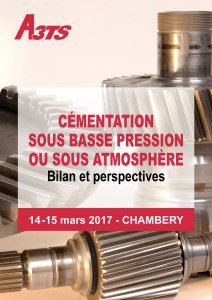Cementation under low pressure or under atmosphere 2017 - CHAMBERY
115 PARTICIPANTS!
These days gathered more than 95 industrial participants and about twenty students at the MANEGE Congress Center in Chambéry.
Summary of the technical part
More than 12 lectures were presented, the first scientific lecture presented by Pascal Lamesle (IRT M2P) gave us an overview of the differences between the two processes.
Low pressure carburizing leads to shorter cycles because of the easier "activity" of the carbon brought by C2H2 (compared to the dissociation of CO) and the more important gradient effect (percentage of carbon on the surface following the impulse of C2H2 / carbon of the part). With vacuum furnaces, the temperature is no longer limited.
To take advantage of this possibility, the steels must be adapted, as Simon Catteau (ASCOMETAL) has shown very well, by playing on the chemical composition to limit grain size. The additions of suitable alloying elements allow to play on the bainitic domain of the TRC diagram, thus, to adapt the hardenability to gas quenching and reduce the deformations.
The conference given by Mr. Atman Benbahmed and Mr. Thibaut Martin of the AUBERT et DUVAL group showed us that there are other case hardening steels than the ones we use every day. In the case of two highly alloyed steels, the usual cycles are no longer applicable. On the one hand, it is necessary to be able to activate the surface of parts made of stainless steels, to case harden them and finally to obtain the desired hardness profile without losing the stainless properties.
The low pressure carburizing furnaces of ECM TECHNOLOGIES, presented by Yves Giraud, have proven themselves on the French market. The development of an "ICBP nano" furnace for carburizing small parts in bulk is underway. It should be noted that the control of the "cementing atmosphere" by an in-situ system is not considered necessary.
In the field of gas cementation adapted to large series, Daniel Zimmermann (AICHELIN) presented some of the improvements made to gas cementation furnaces. Although he agrees that the cycles are shorter, he shows that the cost price is higher with low pressure carburizing.
Jean Paul Bétend presented the French version of Volker Heure's presentation. Compared to ECM, ALD favors gas quenching (Nitrogen or Helium) which allows to limit/control deformations, and potentially, to eliminate grinding. The development of high temperature carburizing (1050°C) allows with the Syncrotherm furnace to integrate the furnace in the machining line.
Nicolas Sallez (SOLO SWISS) illustrated the technology adopted to combat vacuum furnaces. The separation of the case hardening treatment steps, the diversity of the quenching media (liquids, gases, salts) and the in situ control of the atmospheres allow a very high adaptability.
Jean Noel Amadasi (SAFE CRONITE) showed the evolution of the tools used in case hardening. The increase in temperature and the need for good gas circulation under high pressure have been well taken into account. Special CBP tools have been developed.
Alexandre Bonnin (AIRBUS HELICOPTERS) showed us the process followed to replace a very old gas cementation furnace in 2011. The choice of low-pressure carburizing led to numerous developments. The absence of surface oxidation due to the vacuum technology is interesting for the non-ground parts.
Still in the aeronautical field, Cyril Vernault (SAFRAN HELICOPTERS ENGINE) explained his company's approach to replace a gas carburizing furnace by a vacuum carburizing furnace. He presented a complete comparison of the respective advantages and disadvantages of the two processes for his application.
Andréas Schüler of the ZF Group has compared the deformation characteristics of the oil quenching of the push furnace, the gas quenching of a vacuum furnace with load and the gas quenching of an integrated furnace after high-temperature carburizing. It is clear that the deformations are better controlled with gas quenching, and, the fact of carburizing at 1050°C does not seem unfavorable.
Murielle Rochette (RENAULT) presented a history of the evolution of carbonitriding followed by hot oil quenching and low pressure carburizing. The low pressure carburizing part is very low. This variant could be taken into account in the case of new gearboxes.
Philippe Lapierre (PSA) made a similar presentation for his company. Mechanical results in low pressure carbonitriding offer prospects for improvement.
The final panel discussion provided an interesting discussion:
On the economic aspect in favor of gas cementation
For the same case depth, low pressure case hardening is faster
With a high temperature, the cycle becomes very short, hence the possibility of introducing case hardening directly into the machining line
Gas quenching allows better control of deformation due to quenching
To date, gas carburizing is the most common process used, but low-pressure carburizing is developing significantly. The service life of heat treatment furnaces is more than 30 years, which does not favour rapid market developments.
List of exhibitors :
AICHELIN
ECM TECHNOLOGIES
G.N.R. s.r.l.
MTC









